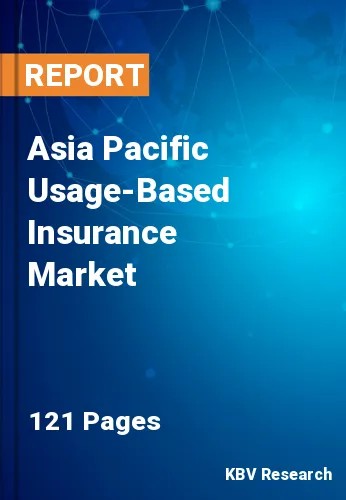The Asia Pacific Usage-based insurance Market would witness market growth of 26.3% CAGR during the forecast period (2023-2030).
The evolution of telematics technology remains a pivotal driver in the market. Innovations such as GPS tracking, accelerometer sensors, and real-time data transmission capabilities empower insurers to gather intricate details about user behavior. As technology advances, telematics devices become more sophisticated, enhancing the accuracy and depth of the data collected. Artificial Intelligence (AI) and Machine Learning (ML) are crucial in extracting actionable insights from the vast datasets generated by UBI systems. These technologies enable insurers to analyze complex patterns, predict future behaviors, and customize risk assessments with a higher degree of accuracy. Integrating AI and ML fosters continuous improvement in risk modeling and pricing strategies.
A notable trend in the market is the adoption of pay-per-use models. Instead of traditional fixed premiums, insurers explore dynamic pricing models where policyholders pay based on usage or risk exposure. This aligns the interests of insurers and policyholders and promotes cost efficiency and fairness in the insurance relationship. While UBI initially gained prominence in personal auto insurance, its applications are expanding across various insurance lines. Commercial auto, property, and casualty insurance sectors are increasingly exploring UBI to enhance risk management, reduce claims, and optimize premiums. This diversification signifies a broader industry recognition of the benefits and adaptability of usage-based approaches.
Invest India reports that between April 2021 and March 2022, the automobile industry manufactured 22.93 million vehicles. The Automobile Sector attracted 5% of the total FDI inflow, according to the DPIIT Report from June 2023. Exports of passenger vehicles increased by 42.9% between April 2021 and March 2022, from 404,397 to 577,875 units, while exports of commercial vehicles rose from 50,334 to 92,297 units. The automotive industry in India encompasses a diverse range of vehicles, including two-wheelers, passenger cars, commercial vehicles, and electric vehicles. UBI programs can cater to this diversity by offering customized insurance solutions tailored to different types of vehicles and their usage patterns.According to the 14th Five-Year Plan (2021-2025), China aims to increase its urbanization rate to 65%. As urbanization progresses, there is a notable increase in vehicle ownership in major Chinese cities. UBI programs can tap into this urban demographic, offering personalized insurance options. Therefore, the factors mentioned above will propel market growth in this region.
The China market dominated the Asia Pacific Usage-Based Insurance Market by Country in 2022, and would continue to be a dominant market till 2030; thereby, achieving a market value of $13,557.4 Million by 2030. The Japan market is registering a CAGR of 25.4% during (2023 - 2030). Additionally, The India market would showcase a CAGR of 27% during (2023 - 2030).
Free Valuable Insights: The Global Usage-Based Insurance Market is Predict to reach $161.5 Billion by 2030, at a CAGR of 25.5%
Based on Vehicle Age, the market is segmented into New Vehicles, and Used Vehicles. Based on Policy, the market is segmented into Pay-As-You-Drive (PAYD), Pay-How-You-Drive (PHYD), and Manage-How-You-Drive (MHYD). Based on Vehicle Type, the market is segmented into Light-Duty Vehicle (LDV), and Heavy-Duty Vehicle (HDV). Based on Technology, the market is segmented into Black Box, OBD (On-Board Diagnostics)-II, Smartphone, and Hybrid. Based on countries, the market is segmented into China, Japan, India, South Korea, Singapore, Malaysia, and Rest of Asia Pacific.
By Vehicle Age
By Policy
By Vehicle Type
By Technology
By Country
Our team of dedicated experts can provide you with attractive expansion opportunities for your business.

